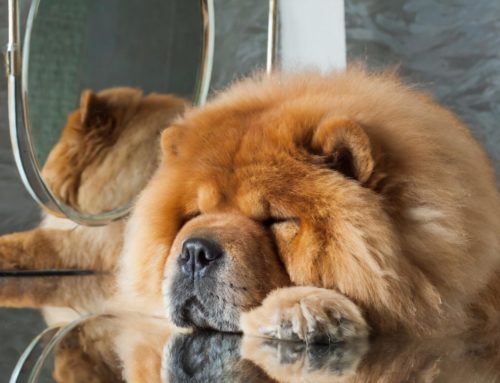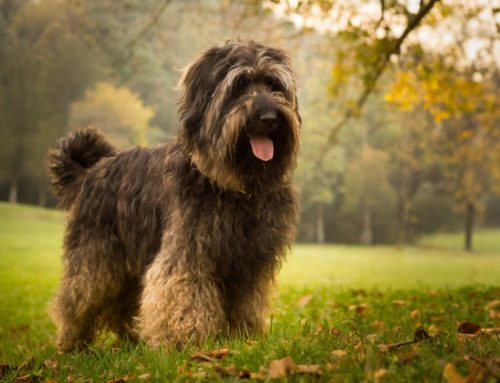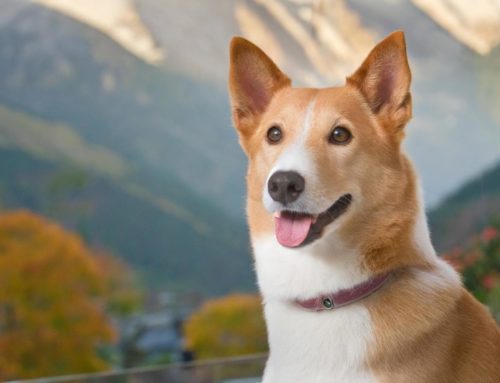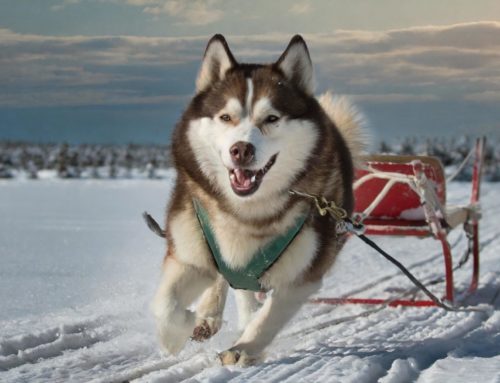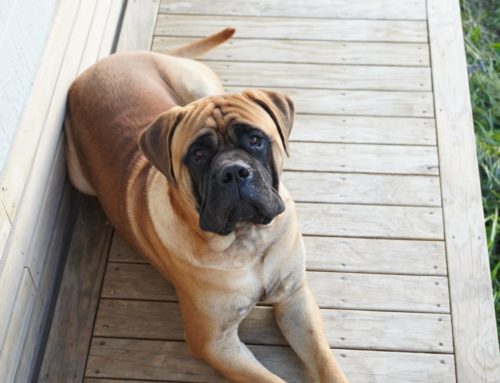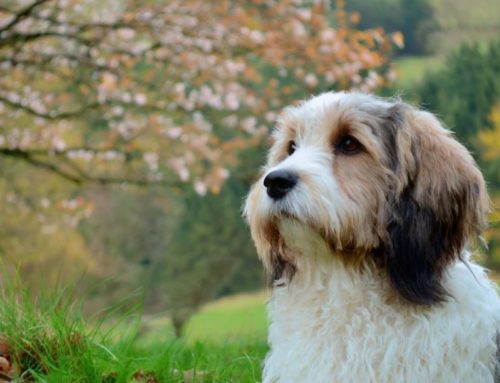
The Ca de Bou, or Perro de Presa Mallorquin, is a historic breed of dog originating from the island of Mallorca. Known as a good guard dog, this breed has a muscular build and an impressive appearance. The name Ca de Bou literally means “Bulldog of Mallorca”. These dogs were traditionally used for dog fighting, a now-banned activity.
The Ca de Bou was created by crossing local dogs with English Bulldogs, which were brought to Majorca by British settlers. The result was a strong and muscular dog, suitable for fighting and as a guard dog. With the ban on dog fighting, the Ca de Bou took on a new role as a companion and guard dog.
Although the Ca de Bou is an energetic dog that needs a lot of exercise, it is content to relax in its home, especially with those in its inner circle.
It was not until the 1980s that the Ca de Bou was officially recognised and respected as a good guard dog. Today, the breed is known for its friendliness towards household children and its ability to be relaxed in their homes, although it is still cherished for its watchfulness and protective instincts.
FCI Group 2 Pinscher and Schnauzer
This breed belongs to the FCI (Fédération Cynologique Internationale) Group 2, which consists mainly of Pinscher and Schnauzer – Molossoid breeds, and Swiss Mountain Dogs. Within this group are breeds known for their strength, courage and loyalty, characteristics that the Ca de Bou has in abundance.
The appearance of this Mastiff
The Ca de Bou, also known as the Majorcan Mastiff or Spanish Bulldog, is a unique breed of dog. These dogs have a slender and muscular body, weighing between 30 and 34 kg for bitches and between 35 and 38 kg for males. Their coat is short, often with a black mask and sometimes a small number of white spots.
Breeders of the Ca de Bou appreciate the loving spirit of these dogs. These dogs are known for their energetic nature and need a lot of exercise. Despite their powerful appearance and size, Ca de Bou’s are content to relax with their owners.
Hereditary diseases and disorders in the Majorcan mastiff
A robust and energetic dog breed, the Ca de Bou is known for its loyalty and strength. However, like many breeds, it is prone to certain hereditary diseases and disorders.
Here is a list of the most common ones:
- Hip dysplasia: This is a common condition in larger breeds. It involves abnormal development of the hip joint, which can lead to pain and mobility problems.
- Elbow dysplasia: Similar to hip dysplasia, this involves an abnormality in the elbow joints, which can result in pain and lameness.
- Demodectic Scabies: This is caused by a mite and can lead to skin problems such as baldness and infections.
- Gastric Dilatation-Volvulus (gastric torsion): A life-threatening condition in which the stomach fills with gas and twists, cutting off the blood supply.
- Atopic Dermatitis: A chronic skin condition that leads to itching and inflammation, often caused by allergies.
- Eye problems: Including cataracts and progressive retinal atrophy, which can lead to impaired vision or blindness.
- Heart diseases: Such as cardiomyopathy, a disease of the heart muscle that can affect pumping function.
The character of the Ca de Bou
The Ca de Bou, a majestic Spanish Bulldog, is known for its unique character. These dogs are robust and powerful, but at the same time possess a calm and balanced personality.
Their temperament makes them excellent family dogs, provided they are well socialised and raised. The Ca de Bou forms a strong bond with its family and is especially loyal and protective. Despite their imposing appearance, Ca de Bous are surprisingly affectionate and patient, especially with children.
They are intelligent and eager to learn, which makes training relatively easy, although they can sometimes be stubborn. Consistency and a positive, reward-oriented approach work best with these dogs. The Ca de Bou is naturally watchful and will protect its family, but is not aggressive without reason.
They are reserved towards strangers and need time to build trust. These dogs have a moderate energy level; they enjoy daily walks and play sessions, but are also content with quiet time at home.
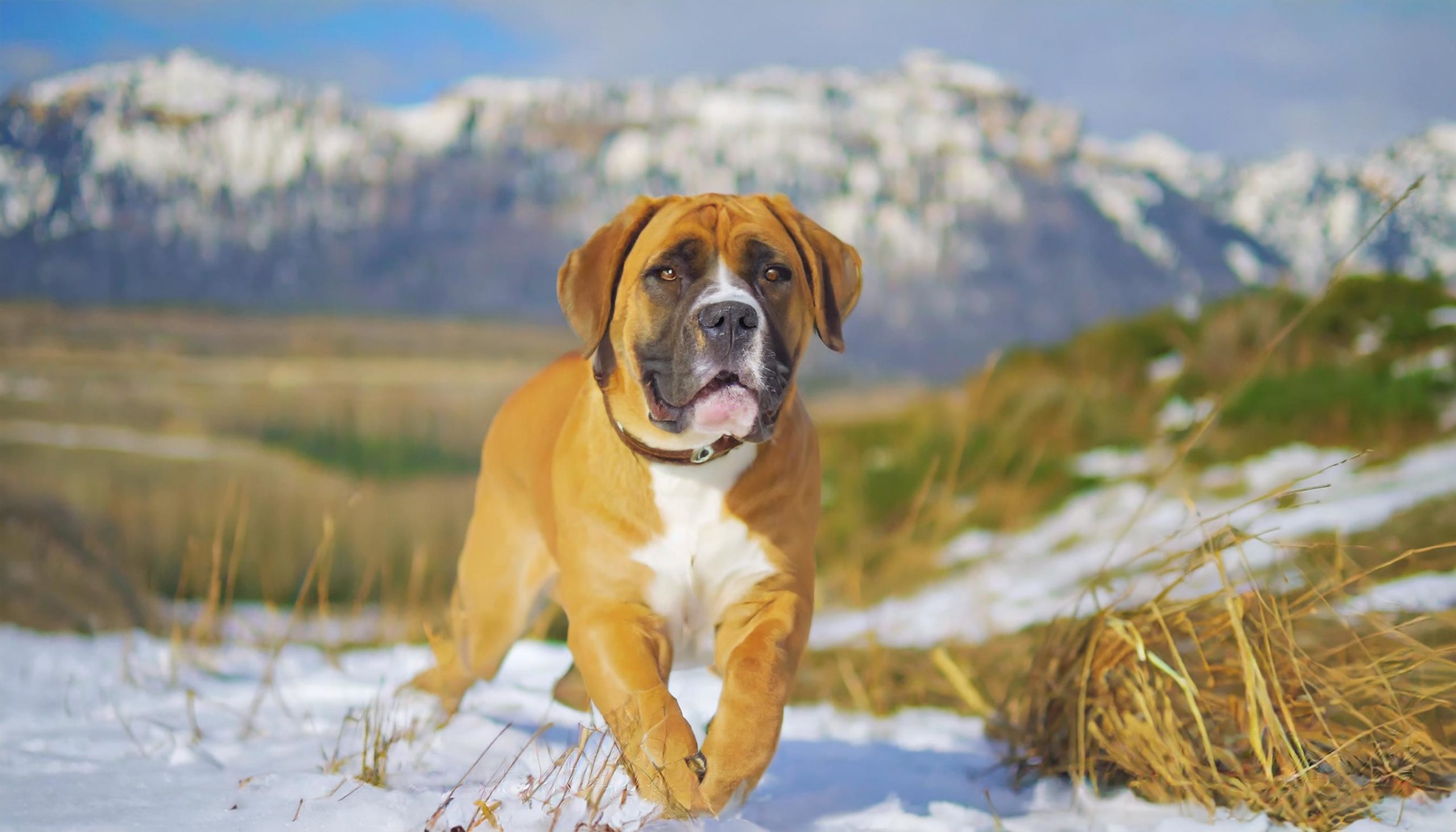
The Care of the Ca de Bou
The care of a Ca de Bou, known for its robust and tough appearance, requires specific attention to keep it healthy and happy. Here are some essential aspects of grooming:
- Coat care: The Ca de Bou has a short, smooth coat that requires relatively little maintenance. Regular brushing, about once a week, is sufficient to remove loose hair and keep the skin healthy. They do not need to be bathed often, only when they are really dirty, to prevent their skin from drying out.
- Nail care: Nails should be trimmed regularly to avoid discomfort and problems walking.
- Dental care: Dental hygiene is crucial. Regular tooth brushing helps prevent tartar and gum disease. Chew toys can also help keep their teeth clean.
- Ear care: Check their ears regularly for signs of infection, such as redness or an unpleasant odour, and clean them to prevent accumulation of dirt.
- Nutrition: A balanced diet is essential. Give high-quality food that suits their age, size and energy level. Avoid overfeeding to avoid obesity.
- Exercise: They need daily exercise to stay fit and healthy. Walks, playtime and mental stimulation are important.
Socialisation and upbringing of the Ca de Bou
Socialisation and upbringing of a Ca de Bou are crucial for developing a well-adjusted and balanced dog. These powerful and intelligent dogs need a consistent and understanding approach from an early age.
- Early Socialisation: Start socialisation as soon as the puppy is in the house. Introduce him to different people, sounds, environments and other animals. This helps to prevent fear and aggression and ensures that the Ca de Bou grows into a confident and social adult dog.
- Obedience training: basic commands such as sit, stay, come and no are essential. This training strengthens the bond between dog and owner and makes for a more manageable dog.
- Positive Reinforcement: Use positive reinforcement techniques such as praise, treats and play. This encourages good behaviour without intimidating the dog.
- Consistency: Be consistent in rules and boundaries. Ca de Bou’s can be stubborn, so being consistent in training and expectations is important.
- Patience and Understanding: Have patience and understanding during the training process. Each dog learns at its own pace.
- Socialisation with Other Pets: If you have other pets, introduce the Ca de Bou carefully and under supervision.
- Preventing Problem Behaviour: Be alert to signs of dominance or overprotective behaviour and address this early.
- Keep Learning: Keep challenging them with new commands or activities. This keeps their mind sharp and prevents boredom.
How much experience does a Ca de Bou require
Known for its powerful personality and physical stature, the Ca de Bou is a breed ideally suited to experienced dog owners. This breed requires an owner familiar with handling strong, dominant dogs and able to provide consistent and assertive leadership.
Experienced owners are better equipped to handle the specific challenges involved in raising and training a Ca de Bou, including the importance of early socialisation, obedience training and dealing with their strong will.
For inexperienced dog owners, the Ca de Bou can be a challenging breed. Without proper knowledge and experience, new owners may struggle to provide effective leadership and training, which can lead to behavioural problems. It is essential that inexperienced owners are aware of the time, dedication and patience required to raise a Ca de Bou.
Is training necessary?
Training is absolutely essential for a Ca de Bou. This breed, known for its strong will and impressive physical strength, requires consistent and structured training to develop good behaviour and social skills. Without adequate training, a Ca de Bou can become dominant or even unruly, which can pose a risk to both the dog and its environment.
Training should start as early as puppyhood and include basic obedience such as sit, stay, come and walk neatly on a lead. This helps establish clear communication and leadership between the dog and the owner. In addition, it is essential to socialise the Ca de Bou with different people, animals and situations to prevent fear and aggression.
Positive reinforcement techniques work well with this breed, rewarding good behaviour to build trust and respect. Physical force or punishment is not effective and can lead to fear or aggression.
How much exercise does the majorca mastiff need?
A Ca de Bou needs a significant amount of daily exercise to stay healthy and happy. This vigorous and energetic breed requires regular physical activity to support its physical and mental well-being. On average, a Ca de Bou needs about 1 to 2 hours of exercise per day, divided between walks, playtime and other activities.
Long walks are essential for this breed. These walks provide not only physical exercise, but also mental stimulation as they explore new environments and scents. In addition to walks, playtime is important. Activities such as fetch, tug-of-war games, or agility training can help channel their energy in a positive way.
It is also advisable to engage them in interactive games that offer mental challenges, such as toys with treats in them or search games. These types of games keep their minds sharp and prevent boredom.
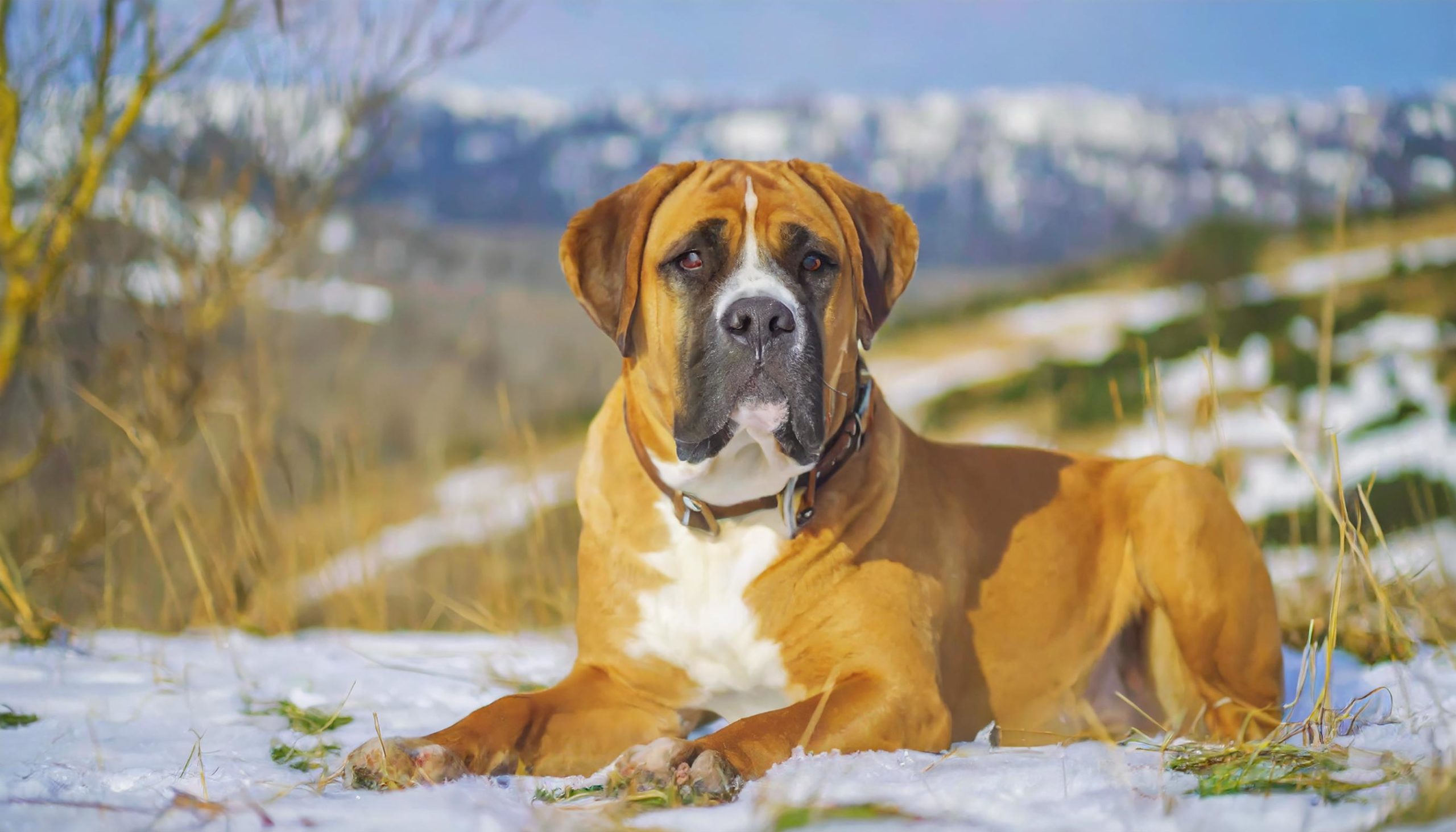
How is it getting along with children?
The Ca de Bou can be a fantastic companion for children, provided it is well socialised and trained. This breed is known for its loyal and protective nature, which makes them excellent family dogs. However, due to their size and strength, it is important to supervise interactions between the Ca de Bou and children, especially when they are young.
The Ca de Bou is generally patient and tolerant, but as with any breed, children need to learn how to interact with the dog in a respectful and gentle manner. Teaching the basic rules of interaction, such as not disturbing the dog while eating or sleeping and avoiding rough play, is crucial.
A well-socialised Ca de Bou will appreciate the presence of children and may even adopt a protective attitude. They get along well with children’s liveliness and are often patient enough to participate in their games.
Benefits of a Ca de Bou
- Loyalty and Protection: Ca de Bous are known for their deep loyalty to their family and are excellent guard dogs.
- Temperament: They have a balanced and calm temperament, making them good companion animals.
- Intelligence: This breed is intelligent and relatively easy to train, making them suitable for a variety of tasks.
- Social with Family: They form strong bonds with their family members and are loving and protective.
Disadvantages of a Ca de Bou
- Size and Strength: Their size and strength can be a challenge, especially if they are not well trained.
- Need for Exercise: They require regular and intense exercise, which is a time investment.
- Potential Health Problems: They can be prone to hereditary health problems such as hip dysplasia.
- Socialisation Needed: Early and consistent socialisation is necessary to prevent behavioural problems.
- Not Ideal for First Dog Owners: Because of their strong personalities, they may not be suitable for inexperienced dog owners.
How old a Ca de Bou gets
The life expectancy of a Ca de Bou, a robust and resilient dog breed, generally varies. These dogs can reach an average age of around 10 to 12 years, depending on various factors affecting their health and well-being.
Price of a Ca de Bou
The price of a Ca de Bou can vary considerably, depending on whether you choose to purchase from a breeder or adopt from a shelter or rehoming organisation.
When buying a Ca de Bou from a recognised breeder, the cost can vary. This price depends on several factors, including the dog’s pedigree, the reputation of the breeder, and the health checks and vaccinations the puppy has already received.
Prices can range from around $1,000 to $2,500 or more. It is important to choose a reliable breeder who has carried out health checks on the parents and adheres to ethical breeding practices.
On the other hand, adopting a Ca de Bou can be a more affordable option. Adoption costs usually range from $50 to $300, depending on the shelter or organisation. These costs often cover basic health care, including vaccinations and spaying or neutering.
